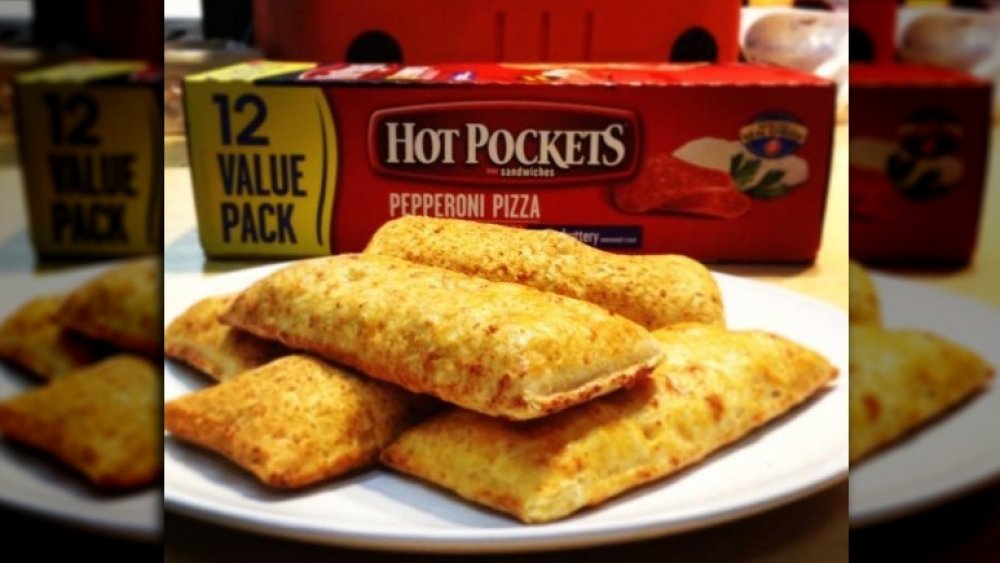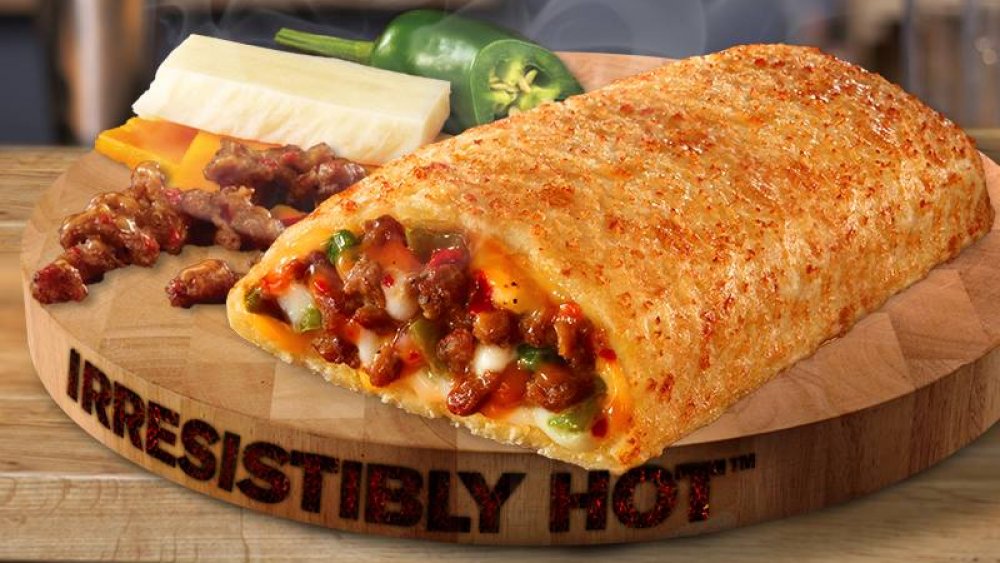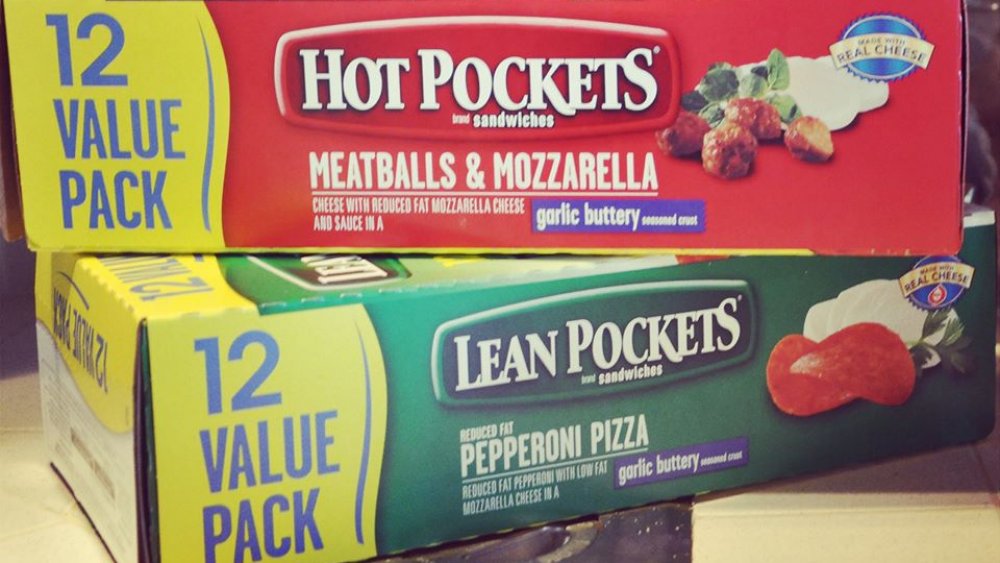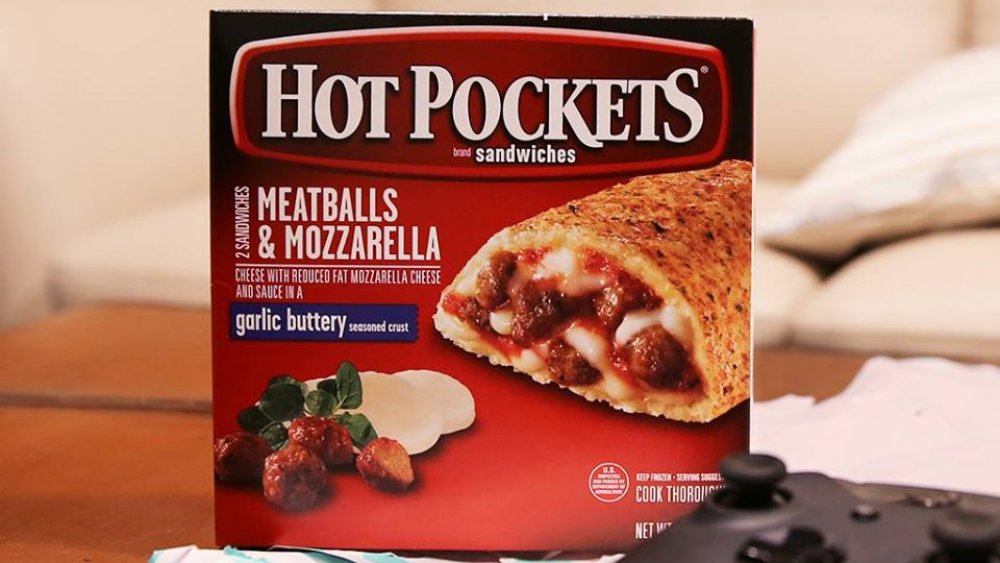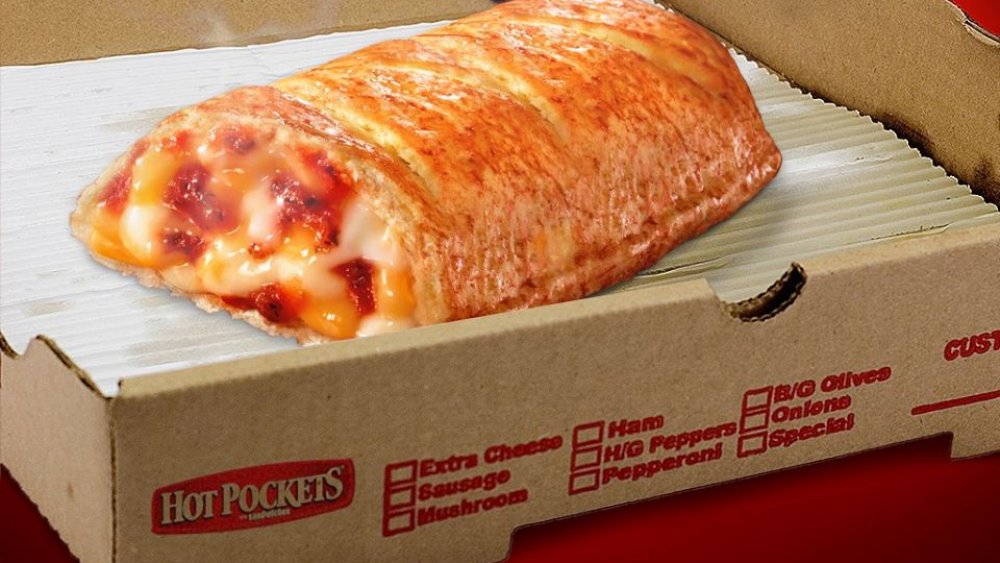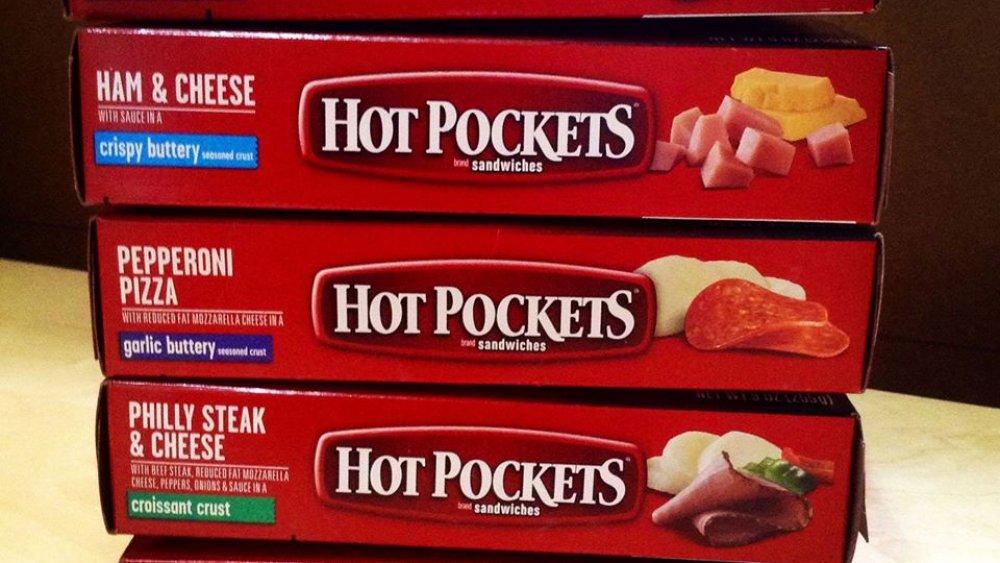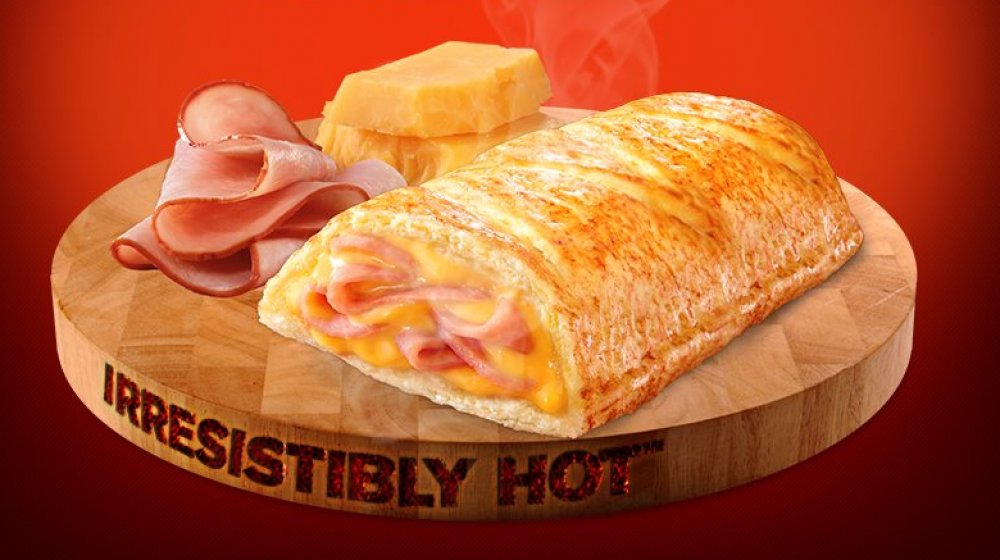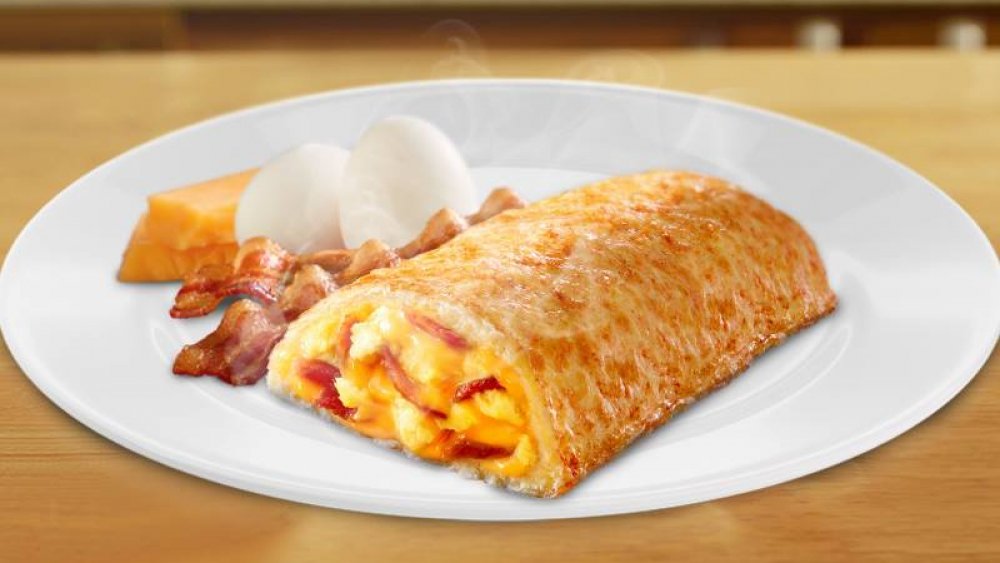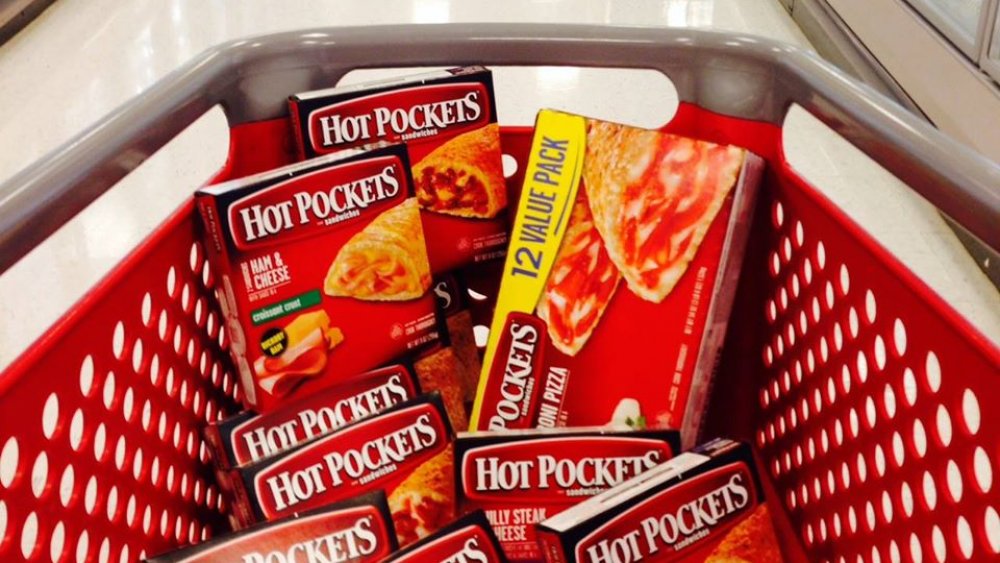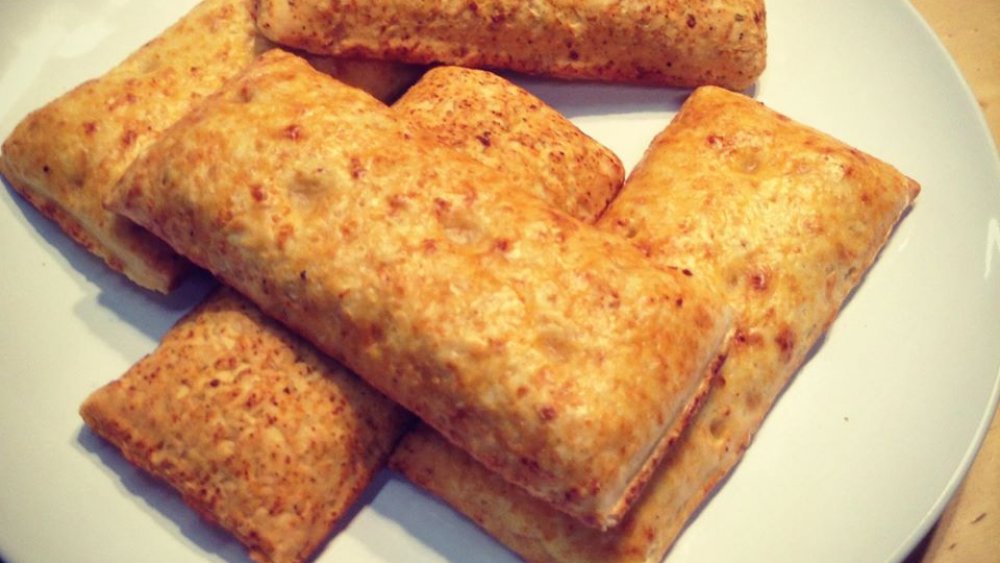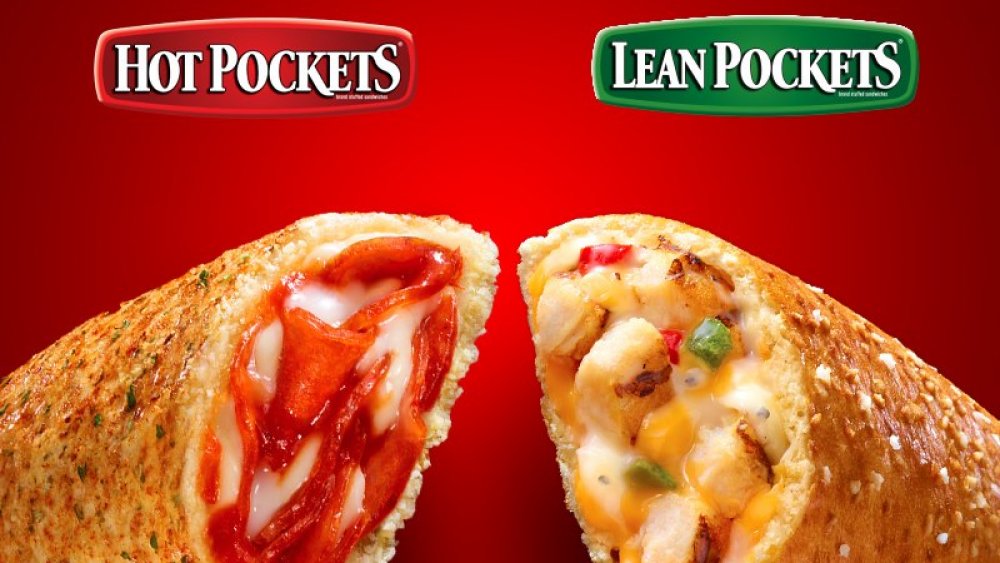Ingredients You'd Be Surprised Are In The Hot Pockets You Are Eating
Hot Pockets — the tasty microwaveable sandwiches you can cook in two minutes — have been staples of workplace lunches, after school snacks, and breakfasts on-the-go for more than three decades, first available to the public in 1983. Unfortunately, though, the company website's claims of "made with real cheese" and "no artificial flavors," are a little misleading; a fact that's especially obvious if you take a careful look at each product's list of ingredients. These lists are long and full of hard-to-pronounce chemicals (naturally-occurring chemicals, obviously) used to amp up flavor, consistency, and overall freezer-life.
Of course, you're probably not assuming that the pepperoni pizza Hot Pocket you're zapping in the microwave as you walk out the door is a beacon of health and wellness — at least a few unpronounceable ingredients are probably to be expected. But you might be surprised to learn that that 100 percent cheese you're counting on eating? It may not be available in every single Hot Pocket product. And if you think the "good source of protein" you're eating is purely from meat and cheese? It's time to think again.
Here's what you're really consuming when you eat your next Hot Pocket. It may not be what you think.
Hot Pockets contain sugar
Hot Pockets, and their "healthier" version, Lean Pockets, are basically bread stuffed with meats, cheeses, and (sometimes) vegetables. It's not the type of meal you expect to taste sweet or to feature sugar as a primary ingredient. But pretty much every Hot Pocket contains between two and eight grams of sugar — a touch of sweetness hiding behind the more savory flavors of fat and salt. According to the company's website, the most popular Pepperoni Pizza Hot Pocket contains 14 grams of fat and 630 milligrams of sodium — enough to mask its 3 grams of sugar.
Of course, sugars occur naturally in vegetables and milk products, so it's not a surprise that a product with cheese would include some sugars, but if you're trying to stay away from added sugars in your diet, it's important to pay attention. According to the Mayo Clinic, people sticking to a 2,000 calorie a day diet should try to consume fewer than 48 grams of sugar per day. If one BBQ Recipe White Meat Chicken Lean Pocket contains 8 grams of added sugars, you'll need to be careful about how much additional sugar you can consume in your other meals and snacks throughout the day.
The reality is, sugars are often included in processed foods like Hot Pockets because they add texture, flavor, and they help bread to rise. Given that the Hot Pockets brand prides itself on its crispy crusts and breads (that handy sleeve is not for nothing!), it makes sense that a little sugar would be used in each Hot Pocket product.
Hot pockets use food coloring
Why, oh why, do Hot Pockets contain food coloring?
Considering that the bulk of the Hot Pocket is wrapped in a casing of crust or bread, you'd think that food coloring would be unnecessary. But according to the company's ingredient lists, pretty much every Hot Pocket product uses some type of food coloring — especially caramel coloring for beef or meatball products, and annatto or turmeric to enhance the yellows of cheese and eggs.
According to the American Chemical Society, processed foods (like Hot Pockets) need food coloring to make them more appealing to the eye. The website likens food colorings to cosmetics, pointing out that without food coloring, hot dogs would be gray — which, admittedly, sounds a lot less appealing than the brown, "meaty" color people have come to expect of hot dogs. And while you're probably not spending a ton of time dissecting what your Meatballs & Mozzarella Lean Pocket looks like on the inside after that first bite, you'd probably notice if the meat looked gray — and there's a good chance it would be your last Hot Pocket. Hence, the added caramel color.
Hot Pockets contain textured vegetable protein
Textured vegetable protein sure doesn't sound appealing, but if you've enjoyed a Hot Pocket recently (specifically, one of the company's many Hot Pocket products that feature meatballs or hamburger), you probably weren't off-put by the addition of this ingredient. You probably didn't even notice it was there.
The How Stuff Works website explains that textured vegetable protein is often used as a meat replacement or meat extender. In essence, it's a soy-based protein that looks and tastes similar to ground beef. Also, to be clear, it's less expensive than beef. So when companies like Nestle (the parent company of Hot Pockets) add textured vegetable protein to a product like Hot Pockets, it's almost certainly to make it appear that there's more beef in the product than there actually is.
This addition allows them to use less ground beef while maintaining the flavor and texture of meat and reducing the overall cost to produce each product. Really, if you can't taste the difference, it's actually a smart business ploy.
Hot pockets contain imitation cheese
If you're the type who likes to stay away from imitation cheeses, pay close attention to which Hot Pockets products you purchase. While some of their products (like the ever-popular Pepperoni Pizza) tout "made with real cheese," it's not a brand-wide promise.
Take, for instance, the fact that the Chicken Broccoli & Cheddar Hot Pockets feature "imitation cheddar cheese" as an ingredient immediately following real cheddar cheese on the ingredient list. Tricky, tricky, Hot Pockets!
The reality is, imitation cheeses function similarly to textured vegetable proteins — they offer companies a way to "extend" a natural product with an imitation that looks and tastes a lot like the real thing. According to a chapter in Cheese: Chemistry, Physics and Microbiology, the milkfats in imitation cheeses are partially or entirely removed from the cheese and are replaced with nonmilk-based alternatives, often vegetable fats. The overall processing and result of imitation cheese is almost identical to regular cheese, and the flavor is often very similar. This allows companies to provide more cheese flavoring and texture in their products without the expense of actually adding more real cheese.
The catch is that it's unclear why some Hot Pockets products use imitation cheese while other Hot Pockets varieties don't. For instance, the Cheddar Cheeseburger and Beef Taco Hot Pockets both include imitation cheddar cheese, but Steak & Cheddar Hot Pockets don't.
So what's the takeaway to this one? Pay attention and read the ingredient list carefully when you're making your purchase.
Hot Pockets also contain cheese with sodium citrate
If you've ever melted cheddar cheese in a dish, you've probably witnessed what happens when the cheese cools down — the fat separates from the solids and you get a weird congealed mass of what remains of the hard parts of the cheese in a gross puddle of grease. It's not exactly the creamy, melty goodness that makes food look appealing. The experience is different with American cheese or with products like Velveeta or canned nacho cheese. When these cheeses are heated, they have a smooth consistency that's perfect for cheese dips or grilled cheese sandwiches.
The secret to these products? Sodium citrate. According to Cooks Illustrated, sodium citrate is a salt solution with a sour-salty taste. Older or harder cheeses that have less liquid content are harder to melt with a smooth consistency because when heated, the fat breaks away from the solids and separates. When sodium citrate is added to older or harder cheeses, the sodium citrate substitutes itself for some of the calcium that makes these cheeses stick together, preventing the fats from completely separating, and providing for a smoother, easier melt.
While not all Hot Pockets products contain sodium citrate, the Beef Taco and Chicken Broccoli & Cheddar versions each contain imitation cheddar cheese that includes sodium citrate as part of the ingredients. It's not clear why some products feature sodium citrate and others don't, but you can expect a creamy/smooth consistency of the cheddar cheese when eating these Hot Pockets.
There is dough conditioner in Hot Pockets, too
If you've ever eaten a Hot Pocket, you've eaten a dough conditioner — it's an ingredient (with a slew of other ingredients of its own, including salt, garlic powder, and enzymes) included in every single Hot Pockets product.
But what in the world is a dough conditioner? According to Bakerpedia, dough conditioners improve dough processing and the quality of baked goods in high-production environments. In other words, when companies need to make a lot of identical products all at once, and they need to turn them over fast, dough conditioners help ensure and improve the quality of the bread or baked goods produced. It helps to ensure the consistency of the product time and time again.
Specifically, Bakerpedia gives dough conditioners credit for improving crust development and color, general appearance and symmetry, shelf-life, and crumb structure of bread. Considering that the Hot Pocket brand places a very high value on the crispy, flaky texture of its bread, it makes sense that they would use a dough conditioner during their production process.
Hot Pockets contain lactic acid
Lactic acid isn't a term most people throw around when talking about cooking — most people think of lactic acid in terms of a tough workout — it's what causes the burning sensation that you feel in your muscles as you push yourself to exhaustion. But lactic acid is included in the ingredient list of most Hot Pockets products, sometimes three or four times, as with the Philly Steak & Cheese and Ham & Cheddar varieties.
So why, exactly, is lactic acid an ingredient in Hot Pockets? Well, the Biomed Central website explains that lactic acids are actually bacteria that are often used in food fermentation, as with cheese, yogurt, and kimchi. These bacteria are "good" bacteria that help kill bad bacteria and keep food safer. The lactic acid included in Hot Pockets is most often listed as a part of its "seasoning" along with things like salt, onion powder, garlic powder, and cheddar cheese powder. But it's also included as a component of its pepperoni. It's not entirely clear why lactic acid plays an important role in the production of Hot Pockets, but it's almost assuredly used as a preservative to extend the life and safety of these microwavable sandwiches.
Hot Pockets include buttermilk powder
Buttermilk powder probably isn't an ingredient you'd automatically assume is included in a variety of Hot Pockets, but each of the breakfast versions (whether Hot Pockets Sausage Egg & Cheese or Lean Pockets Applewood Bacon, Egg & Cheese) includes buttermilk. When you think about it, it makes sense. Nothing says "breakfast" more than a hot, buttermilk biscuit, right? So why wouldn't Hot Pockets amp up its breakfast crust with the sharp and sour addition of buttermilk powder?
And if you've never heard of buttermilk powder, it's a "secret" baking ingredient for many chefs. Alice Osborne, a writer for Cook'n, swears by adding it to biscuits, cakes, fried chicken, and even soups. She points out that using the powdered product is a much better option for long-term shelf-life than buying and using liquid buttermilk from the dairy aisle. More proof positive that there's an art to making irresistible processed foods like Hot Pockets.
Hot Pockets are made with whey
You might be familiar with whey in one of two contexts — the Little Miss Muffett nursery song that refers to "curds and whey" in the context of cheesemaking (where whey is considered a waste byproduct of making cheese), or whey protein powder, where whey (produced during cheesemaking) is used as a nutritional supplement after-the-fact. What you might not be aware of, however, is that, according to 2018 research published in the Journal of Dairy & Veterinary Sciences, whey is frequently "recycled" in the food industry as a part of making secondary dairy products.
The reasons are two-fold: first, the whey produced during cheesemaking is actually the bulk of the milk needed to make cheese — according to Science Learning Hub, about 80-percent of the volume of milk used during cheesemaking remains as whey. Cheesemakers have to figure out an environmentally-safe way to dispose of this "waste;" and second, whey is highly nutritionally-dense. While it's considered "waste" to cheesemakers, whey contains roughly 20-percent of the protein found in milk hence, its common use as a protein powder for nutritional reasons.
The research published in the Journal of Dairy & Veterinary Sciences indicates that when whey is added to foods, as with many of Hot Pockets' varieties including its Pepperoni Pizza version, it usually functions to increase cheese yield and protein content without affecting the flavor or consistency of the cheese used. For companies like Nestle, which produces Hot Pockets, it's a good way to keep the flavor high and costs low.
There is palm oil in Hot Pockets
If you check the ingredients list on almost any Hot Pockets product, you'll see "palm oil" listed at least once, if not more. For many people, the inclusion of palm oil in processed foods is a bit of a red flag. As discussed in a Q&A for the Harvard Health Publishing website, palm oil, like coconut oil, has gotten a bad rap for many years due to its high saturated fat content. But because palm oil is semi-solid and stable at room temperature, companies that produce processed foods, like Hot Pockets, started turning to palm oil as an affordable alternative to trans fats after the US banned the addition of trans fats to foods sold in grocery stores.
The good news is, like coconut oil, the high-saturated fat content found in palm oil doesn't need to scare you. While too much fat in your diet, particularly saturated fat, should be avoided, palm oil contains vitamin E and tocotrienols, which function as antioxidants that may help protect brain and heart health. As long as you're not eating an excess of Hot Pockets (or other processed foods), and you're incorporating them into a balanced and healthy diet heavy on the fruits and vegetables, a little palm oil here or there is unlikely to be harmful to your overall health.
Hot Pockets contain high fructose corn syrup
High fructose corn syrup has gotten a pretty bad rap. It's not that there's no merit to the concerns about the addition of this sweetener to many processed foods, but just because a product, like Hot Pockets' Cheddar Cheeseburger or Lean Pockets' BBQ Recipe White Meat Chicken contains high fructose corn syrup, that doesn't mean you should immediately nix it from your grocery list. The reality is that many food companies started adding high fructose corn syrup to processed foods as a slightly less expensive ingredient than regular table sugar. And as sugar intake as a whole increased in the United States, so did health concerns like Type II Diabetes and heart disease.
But, as Registered Dietitian Katherine Zeratsky points out for the Mayo Clinic website, the real concern isn't with high fructose corn syrup itself, but rather, the total increase in sugar intake in the American diet. While some people have voiced concerns that the body processes high fructose corn syrup differently than it processes regular sugar, research studies have failed to back this assertion. So, if your sugar intake, as a whole, remains reasonably low (the Mayo Clinic states that people consuming a 2,000 calorie diet should keep all sugar intake below 48 grams per day), having a little high fructose corn syrup in your diet is unlikely to be the downfall of your overall health.
